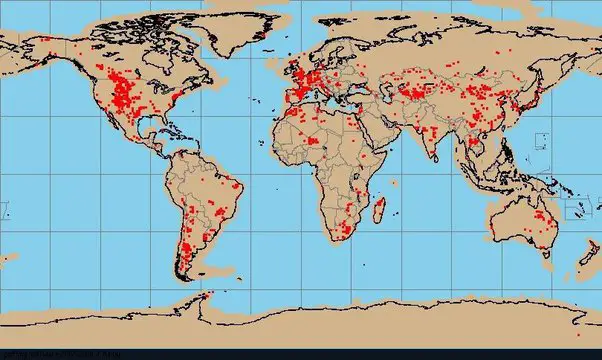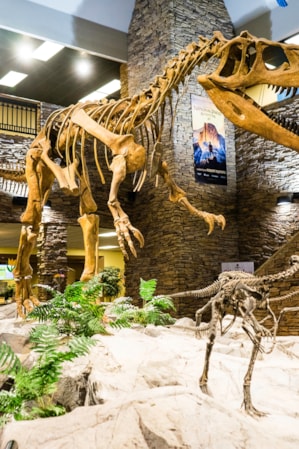Where Have Dinosaur Fossils Been Found: Global Hotspots Revealed
Dinosaur fossils have been uncovered on every continent on Earth. The most significant finds are in North America, Asia, and South America.
Exploring the remarkable world of dinosaurs takes us across the globe, where millions of years of history are buried within the earth’s layers. The discovery of dinosaur fossils has offered scientists a peek into a past where these magnificent creatures roamed freely.
North America’s vast badlands, Asia’s Gobi Desert, and Argentina’s Patagonia region are especially rich in fossil records, providing a treasure trove of paleontological wealth. The vast assortment of fossils includes everything from tiny, feathery creatures to colossal, fearsome predators. This global distribution of finds not only confirms the widespread existence of dinosaurs but also helps researchers understand the diverse climates and ecosystems in which they lived. The hunt for dinosaur remains is relentless, as each new find can alter our understanding of these ancient beasts and the world they inhabited.

Unearthing The Giants: Prime Dinosaur Fossil Locations
Dinosaurs once roamed the Earth, leaving behind clues in the form of fossils. Discovering these ancient remains offers a glimpse into a past world. Paleontologists dig around the globe to find these treasures. Let’s explore some of the top spots where dinosaur fossils were uncovered.
The Badlands of North America are a gold mine for dinosaur fossils. Among these rocky formations, the bones of giants lie in wait. States like Montana, North Dakota, and South Dakota are famous for their rich fossil beds. Noteworthy discoveries include the formidable Tyrannosaurus rex and the plant-eating Triceratops. These lands continue to yield new secrets, revealing more about the prehistoric world each year.
- Montana: Known for T-rex discoveries
- North Dakota: Home to duck-billed hadrosaurs
- South Dakota: Site of the Thescelosaurus find
In the last few decades, China has emerged as a hotspot for dinosaur fossils. The country’s Liaoning Province is especially famous for its well-preserved feathered dinosaur specimens. These fossils provide crucial evidence of the link between dinosaurs and birds. Among the finds are the Sinosauropteryx, the first dinosaur with direct evidence of feathers, and the Microraptor, a four-winged raptor.
| Liaoning Province Finds |
|---|
| Sinosauropteryx |
| Microraptor |
Patagonia is a region at the southern end of South America shared by Argentina and Chile. It has provided a wealth of dinosaur discoveries. The Argentinian part of Patagonia is especially rich with finds. It’s the home of the Argentinosaurus, one of the largest known dinosaurs. Recent digs continue to reveal new and exciting species in this land of the giants.
- Argentinosaurus: A massive herbivore
- Giganotosaurus: One of the largest carnivorous dinosaurs
- Titanosaurus: Another giant herbivore

Credit: www.fossilageminerals.com
African Discoveries: Lesser-known But Vital
When we think of dinosaur fossils, places like North America and Asia often spring to mind. Yet, Africa’s rich prehistoric legacy plays a pivotal role in unraveling Earth’s ancient history. Hidden beneath its vast lands lie traces of creatures that roamed the earth millions of years ago. In particular, the Sahara and South Africa have contributed significant finds that have helped scientists piece together the puzzle of the past.
Sahara’s Hidden Treasures
The Sahara desert, a vast expanse of sandy landscapes, holds more than just secrets of ancient civilizations. Beneath its dunes lie some of the most intriguing dinosaur fossil finds. Researchers have unearthed a variety of species, showing that this arid land was once a vibrant ecosystem teeming with life.
- Discoveries include Spinosaurus, which could swim.
- Remains of the plant-eating Ouranosaurus have been found here.
- The predatory Carcharodontosaurus showcased the Sahara’s diverse food chain.
South Africa’s Contribution
Far from the expansive Sahara, South Africa’s rocky layers reveal its own prehistoric marvels.
| Fossil | Age | Significance |
|---|---|---|
| Euskelosaurus | Triassic Period | Helps to understand early dinosaur evolution. |
| Heterodontosaurus | Early Jurassic Period | Highlights diverse feeding strategies. |
| Aardonyx | Early Jurassic Period | Provides insight into the shift from bipedal to quadrupedal dinosaurs. |
Europe’s Role In Dinosaur Paleontology
Europe, a land rich with history, played a pivotal role in the world of dinosaur paleontology. Its diverse landscapes hold the secrets of the Jurassic age. Explorers across this vast continent have uncovered an impressive array of dinosaur fossils. This reveals a part of the past when massive creatures ruled the land. Let’s delve into some of the most significant discoveries and the places that keep the tales of these ancient giants alive.
United Kingdom’s Jurassic Heritage
The United Kingdom stands as a cornerstone of Jurassic discoveries. The Cliffs of Lyme Regis, along the Dorset coast, whisper stories of prehistoric times. Renowned fossil hunter Mary Anning once scoured these beaches, unearthing ancient marine reptiles and intriguing dinosaur remnants.
- Isle of Skye: A treasure trove of footprints and bones from the Middle Jurassic period.
- Oxfordshire: Home to the predatory Megalosaurus, the first scientifically described dinosaur.
Germany’s Historic Finds
In Germany, the Solnhofen limestone quarries hold a special place in paleontology. This is where the Archaeopteryx, the so-called first bird, was found. With both avian and reptilian features, it remains pivotal in understanding the evolution of birds from dinosaurs. The German region of Bavaria presents astounding findings such as the Juravenator, revealing more about the diversity of life millions of years ago.
| Location | Discovery |
|---|---|
| Solnhofen | Archaeopteryx |
| Bavaria | Juravenator |
Both the United Kingdom and Germany showcase significant finds that continue to shape our understanding of dinosaur paleontology. The fossils unearthed in these regions have enlightened scientists and enthusiasts alike. They illustrate a long bygone era of Earth’s magnificent natural history.
Australia And Antarctica: Poles Apart But Paleontologically Connected
Australia and Antarctica stand on opposite ends of the globe. Yet, these two continents share a deep connection buried within their cold rocks and arid deserts. Studying their unique fossil records bridges a gap millions of years wide, unveiling the mysteries of prehistoric life that once thrived on these lands.
Australia’s Diverse Dinos
Australia offers a glimpse into a world where dinosaurs roamed in diverse ecosystems. Excavations paint a detailed portrait of life from the Triassic to the Cretaceous period.
- Minmi, with its armor-like skin
- Australovenator, nicknamed “Banjo”
Antarctica’s Frozen Secrets
The icy terrain of Antarctica hides well-preserved secrets of the past. Despite harsh conditions, significant discoveries provide clues to a once lush landscape.
| Creature | Period |
|---|---|
| Cryolophosaurus | Early Jurassic |
| Glacialisaurus | Early Jurassic |
The Impact Of Climate And Geography On Fossil Preservation
Dinosaur fossils are windows into an ancient past. Finding these precious remnants requires the perfect blend of climate and geography. Certain conditions safeguard fossils for millions of years. Others can obliterate traces before anyone spots them. Let’s explore how different environments influence fossil preservation.
Desert Climates And Fossil Formation
Deserts, with their dry conditions and shifting sands, serve as powerful agents in preserving dinosaur remains. Low humidity slows the decay of organic material, while limited vegetation means fewer roots to disturb the resting place of dinosaurs.
- Little Rain: Rare rainfall means less erosion and movement of sediments, allowing fossils to stay intact.
- Sandstorms: While they can uncover fossils, they can also rapidly bury bones under sand, protecting them from the elements.
- Stable Ground: Without frequent soil turnover, bones can remain undiscovered for millennia.
Mountain Ranges: Natural Barriers To Fossilization
In contrast, mountain ranges present formidable challenges to fossil preservation. These towering formations can both protect and destroy potential fossil sites.
| Factor | Effect on Fossil Preservation |
|---|---|
| Elevation | High altitudes can lead to erosion and rock slides, hindering fossil discovery. |
| Vegetation | Dense forestation can obscure and damage fossil layers hidden beneath. |
| Accessibility | Rugged terrain makes reaching and excavating fossil sites more difficult. |
Fossils might form in these areas, but finding them proves a strenuous task. The natural barriers created by mountainous landscapes often leave potential discoveries hidden away from paleontologists’ eager hands.

Credit: www.visitutah.com
Future Fossil Hotspots: Predictions And Possibilities
Embarking on a prehistoric journey, we delve into Future Fossil Hotspots: Predictions and Possibilities. Our planet holds uncharted territories rich with hidden gems from ancient eras. Explorers and scientists radiate with anticipation. They believe the earth still cradles secrets deep in its bosom, waiting to be unearthed.
Unexplored Regions With Potential
Dinosaur enthusiasts and paleontologists alike are eagerly eyeing areas less trotted. These regions show great promise for future discoveries:
- The Antarctic interior: Harsh climates and inaccessible terrain have kept these lands pristine and undisturbed.
- Sub-Saharan Africa: Expansive and geologically diverse, ripe for new findings.
- Deep-sea sediments: Dinosaurs may have settled in places now submerged by rising oceans.
Each site offers a unique opportunity to fill gaps in our prehistoric puzzle.
Technological Advances In Paleontology
Breakthroughs in technology pave the way for uncovering the past:
| Technology | Application | Impact |
|---|---|---|
| Satellite Imaging | Scans Earth’s surface | Identifies potential dig sites |
| Ground-penetrating Radar | Maps subterranean landscapes | Reveals hidden fossil beds |
| Portable X-ray Fluorescence (pXRF) | Analyzes mineral content | Distinguishes fossil from rock |
Such innovations are game-changers in paleontological expeditions, ensuring ethical and precise extractions of prehistoric relics.

Credit: www.nytimes.com
Conclusion
Dinosaur fossils have surfaced globally, from the vast Gobi Desert to the rugged Badlands of North America. Each discovery adds a piece to our prehistoric puzzle, illuminating the earth’s ancient past. As explorations continue, who knows what incredible finds await beneath our feet?
Dive into the mystery and join the quest for these fascinating relics.



